In this article, You will read the Major Soil types in India (Classification and Characteristics of Soil) for UPSC IAS.
Soil
Soil is the topmost layer of the continental crust having weathered particles of rocks. The soils of India are the product of physical factors as well as human factors.
Soil can be simply defined as a mixture of small rock particles/debris and organic materials/ humus which develop on the earth’s surface and support the growth of plants.
Factors that influence soil formation–
- Parent Material
- Relief/Topography
- Climate
- Natural Vegetation & Biological factors
- Time
Soil types in India (Types of Soil)
The first scientific classification of soil was done by Vasily Dokuchaev. In India, the Indian Council of Agricultural Research (ICAR) has classified soils into 8 categories.
- Alluvial Soil
- Black Cotton Soil
- Red Soil
- Laterite Soil
- Mountainous or Forest Soils
- Arid or Desert Soil
- Saline and Alkaline Soil
- Peaty, and Marshy Soil/Bog Soil
This classification scheme is based on constitutional characteristics – colour and the resource significance of the soils.
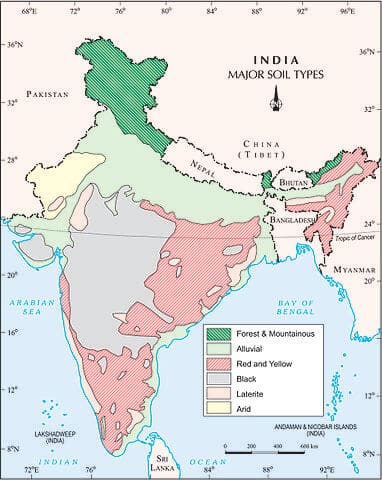
The ICAR has also classified the Indian soils on the basis of their nature and character as per the United States Department of Agriculture (USDA) Soil Taxonomy.
- Inceptisols (39.74%)
- Entisols
- Alfisols
- Vertisols
- Aridisols
- Ultisols
- Mollisols
- Others
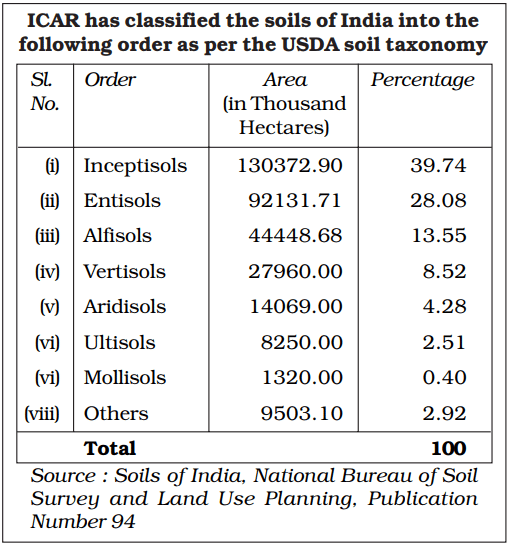
Alluvial Soils
- Alluvial soils are formed mainly due to silt deposited by Indo-Gangetic-Brahmaputra rivers. In coastal regions, some alluvial deposits are formed due to wave action.
- Rocks of the Himalayas form the parent material. Thus the parent material of these soils is of transported origin.
- They are the largest soil group covering about 15 lakh sq km or about 46 percent of the total area.
- They support more than 40% of India’s population by providing the most productive agricultural lands.
Characteristics of Alluvial Soils
- They are immature and have weak profiles due to their recent origin.
- Most of the soil is sandy and clayey soils are not uncommon.
- They vary from loamy to sandy-loam in drier regions and clayey loam towards the delta.
- Pebbly and gravelly soils are rare. Kankar (calcareous concretions) beds are present in some regions along the river terraces.
- The soil is porous because of its loamy (equal proportion of sand and clay) nature.
- Porosity and texture provide good drainage and other conditions favorable for agriculture.
- These soils are constantly replenished by the recurrent floods.
Chemical properties of Alluvial Soils
- The proportion of nitrogen is generally low.
- The proportion of Potash, phosphoric acid, and alkalies are adequate
- The proportion of Iron oxide and lime vary within a wide range.
Distribution of Alluvial Soils in India
- They occur all along the Indo-Gangetic-Brahmaputra plains except in few places where the top layer is covered by desert sand.
- They also occur in deltas of the Mahanadi, the Godavari, the Krishna, and the Cauvery, where they are called deltaic alluvium (coastal alluvium)
- Some alluvial soils are found in the Narmada, Tapi valleys, and Northern parts of Gujarat.
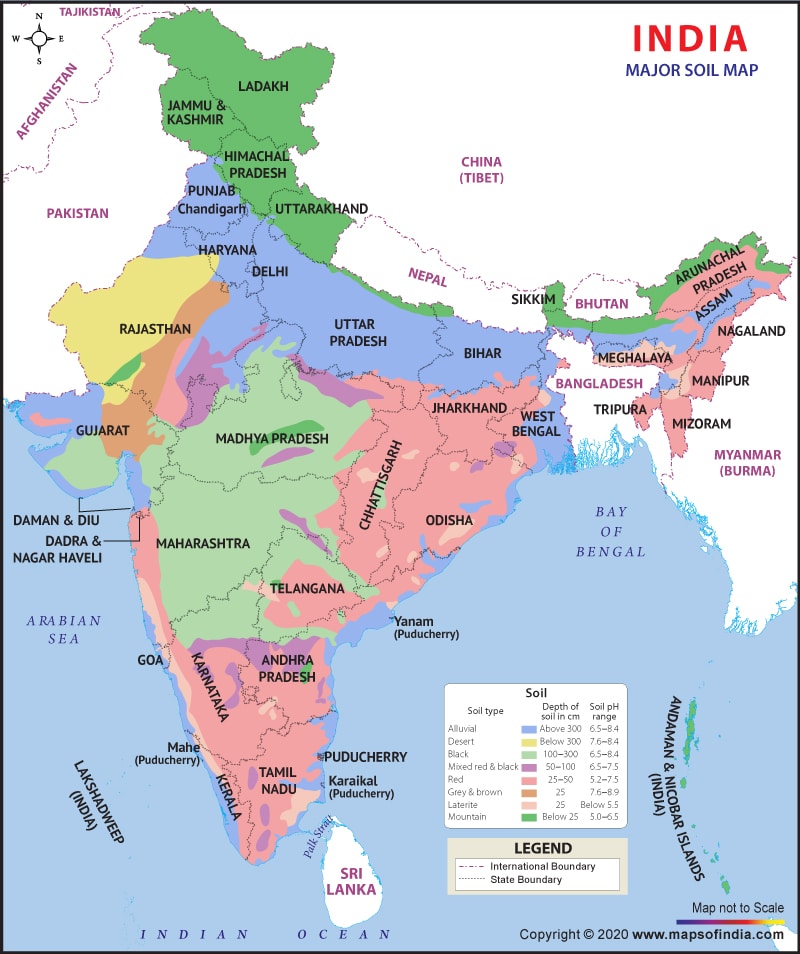
Crops in Alluvial Soils
- They are mostly flat and regular soils and are best suited for agriculture.
- They are best suited to irrigation and respond well to the canal and well/tube-well irrigation.
- They yield splendid crops of rice, wheat, sugarcane, tobacco, cotton, jute, maize, oilseeds, vegetables, and fruits.
Geological divisions of alluvial soils
- Geologically, the alluvium of the Great plain of India is divided into newer or younger khadar and older bhangar soils.
Bhabar
- The bhabar belt is about 8-16 km wide running along the Shiwalik foothills. It is a porous, northern most stretch of Indo-Gangetic plain.
- Rivers descending from the Himalayas deposit their load along the foothills in the form of alluvial fans. These alluvial fans (often pebbly soils) have merged together to build up the bhabar belt.
- The porosity of bhabar is the most unique feature. The porosity is due to deposition of huge number of pebbles and rock debris across the alluvial fans.
- The streams disappear once they reach the bhabar region because of this porosity. Therefore, the area is marked by dry river courses except in the rainy season.
- The area is not suitable for agriculture and only big trees with large roots thrive in this belt.
Terai
- Terai is an ill-drained, damp (marshy) and thickly forested narrow tract (15-30 km wide) to the south of Bhabar running parallel to it.
- The underground streams of the Bhabar belt re-emerge in this belt. It is a swampy lowland with silty soils.
- The terai soils are rich in nitrogen and organic matter but are deficient in phosphate.
- These soils are generally covered by tall grasses and forests but are suitable for a number of crops such as wheat, rice, sugarcane, jute, etc.
- This thickly forested region provides shelter to a variety of wildlife.
Bhangar
- The Bhangar is the older alluvium along the river beds forming terraces higher than the flood plain (about 30 meters above the flood level).
- It is of a more clayey composition and is generally dark-colored.
- A few meters below the terrace of the bhangar are beds of lime nodules known as “Kankar”.
Khadar
- The Khadar is composed of newer alluvium and forms the flood plains along the river banks.
- The banks are flooded almost every year and a new layer of alluvium is deposited with every flood. This makes them the most fertile soils of the Ganges.
- They are sandy clays and loams, drier and leached, less calcareous and carbonaceous (less kankary). A new layer of alluvium is deposited by river floods almost every year.
Alluvial regions with rainfall
- Above 100cm – Suitable for paddy
- B/w 50-100cm – Suitable for wheat, sugarcane, tobacco, and cotton
- Below 50cm– Course grains (millets)
Black Soils
- Formation –formed due to weathering of these basaltic rocks which emerged during fissure eruption of the Cretaceous period.
- The parent material for most of the black soil are the volcanic rocks that were formed in the Deccan Plateau (Deccan and the Rajmahal trap).
- In Tamil Nadu, gneisses and schists form the parent material. The former are sufficiently deep while the later are generally shallow.
- These are the region of high temperature and low rainfall. It is, therefore, a soil group typical to the dry and hot regions of the Peninsula.
- Extent – 15 % of the area
- Black colour is ordained by titani-ferrous magnetic compounds found in basalt.
Characteristics of Black Soils
- A typical black soil is highly argillaceous [Geology (of rocks or sediment) consisting of or containing clay] with a large clay factor, 62 percent or more.
- In general, black soils of uplands are of low fertility while those in the valleys are very fertile.
- The black soil is highly retentive of moisture. It swells greatly on accumulating moisture. Strenuous effort is required to work on such soil in rainy season as it gets very sticky.
- In summer, the moisture evaporates the soil shrinks and is seamed with broad and deep cracks. The lower layers can still retain moisture. The cracks permits oxygenation of the soil to sufficient depths and the soil has extraordinary fertility.
- When dry, it develops cracks and has blocky structure. (Self Ploughing Capacity)
Colour of Black Soils
- The black colour is due to the presence of a small proportion of titaniferous magnetite or iron and black constituents of the parent rock.
- In Tamil Nadu and parts of Andhra Pradesh, the black colour is derived from crystalline schists and basic gneisses.
- Various tints of the black colour such as deep black, medium black, shallow black , a mixture of red and black may be found in this group of soils.
Chemical Composition of Black Soils
- 10 percent of alumina,
- 9-10 percent of iron oxide,
- 6-8 percent of lime and magnesium carbonates,
- Potash is variable (less than 0.5 percent) and
- phosphates, nitrogen, and humus are low.
Rich in iron and lime but deficient in humus, nitrogenous and phosphorous content.
Distribution of Black Soils
- It is found in the Deccan lava plateau region of India.
- Spread over 46 lakh sq km (16.6 percent of the total area) across Maharashtra, Madhya Pradesh, parts of Karnataka, Telangana, Andhra Pradesh, Gujarat, and Tamil Nadu.
Crops in Black Soils
- These soils are best suited for cotton crops. Hence these soils are called as regur and black cotton soils.
- Other major crops grown on the black soils include wheat, jowar, linseed, virginia tobacco, castor, sunflower, and millets.
- Rice and sugarcane are equally important where irrigation facilities are available.
- Large varieties of vegetables and fruits are also successfully grown on the black soils.
- This soil has been used for growing a variety of crops for centuries without adding fertilizers and manures, with little or no evidence of exhaustion.
Red Soil
- This soil developed on Archean granite occupies the second largest area of the country.
- The presence of ferric oxides makes the colour of soil red, ferric oxides occurring as thin coatings on the soil particles.
- The top layer of the soil is red and the horizon below is yellowish.
- Extent – 18.5 % of the area
- Texture: Sandy to clay and loamy.
- This soil is also known as the omnibus group.
Characteristics of Red Soils
- Rainfall is highly variable. Thus, the soil has developed 3 subtypes
- Red & Yellow soil – rainfall is 200cm – NE India – Nagaland, Mizoram, Manipur Hills, parts of Malabar coast, quick drainage is needed
- Red Sandy Soil – Drier plateaus like Karnataka, TN, Telangana, Rayalseema – rainfall from 40-60cm
- RedAlluvial Soil – Along river valleys – has good fertility
- Well drained soil and structure is sandy
- Rich in iron and potash but deficient in other minerals.
Chemical Composition of Red Soils
Generally, these soils are deficient in phosphate, lime, magnesia, humus and nitrogen.
Distribution of Red Soils
They are mainly found in the Peninsula from Tamil Nadu in the south to Bundelkhand in the north and Raj Mahal in the east to Kathiawad in the west.
Significance
- Once irrigated and added with humus, it gives a high yield because the mineral base is rich.
- It supports rice, sugarcane, cotton cultivation
- Millets and pulses are grown in drier areas
- Kaveri and Vaigai basins are famous for red alluvium and if irrigated well, are suitable for paddy
- Large regions of Karnataka and Kerala have developed Red soil regions for rubber and coffee plantation farming.
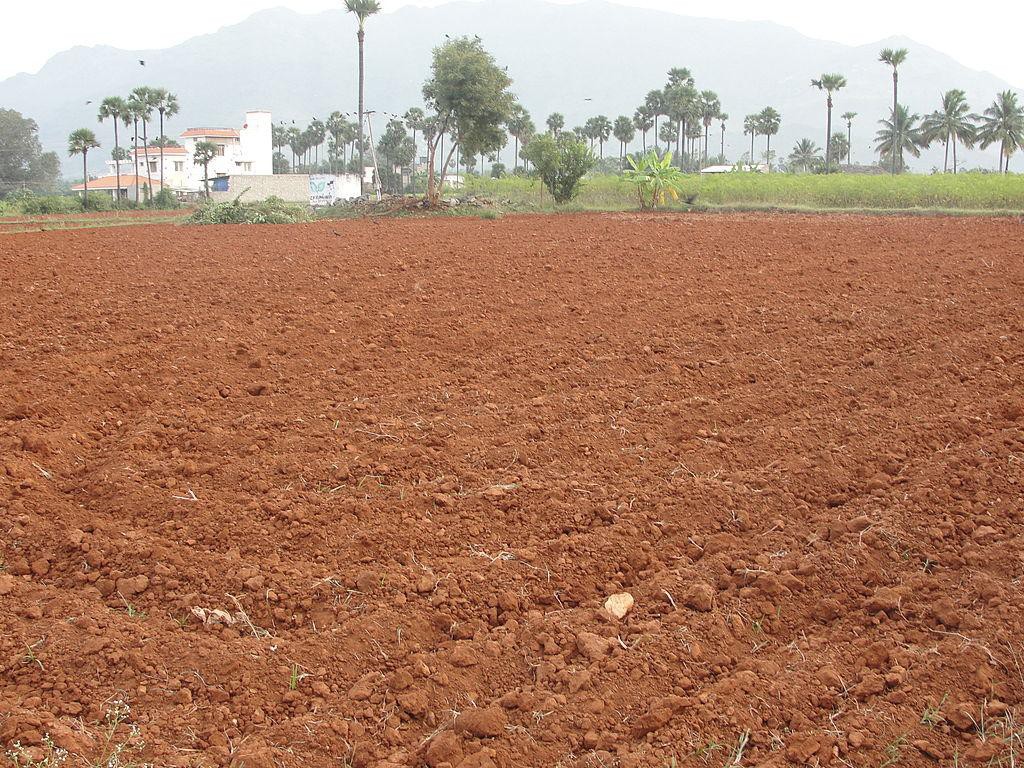
Laterite Soil
Formation
- This soil has emerged in those regions where the following conditions are fulfilled
- There must be laterite rock or structure (Laterites are rich in iron and aluminium content)
- Alternating dry and wet periods are more suitable for the development of laterite soils.
Characteristics
- Brown in colour
- composed essentially of a mixture of hydrated oxides of aluminium and iron.
- Iron oxides are found in nodules form
- Its rich in iron and aluminium but poor in Nitrogen, Phosphorous, Potash, Lime, and Magnesia
- Its humus and water-retaining capacities are moderate
- Bacterial activities have been very high and heavy precipitation develops leaching of humus as a result humus content is moderate to low.
Distribution
- Regions of laterite soil in the country are :
- It is found in patches in Western Ghats ( Goa and Maharashtra).
- In Belgam district of Karnataka and in laterite plateau of Kerala
- In the state of Orissa, in the Eastern Ghats,
- Amarkantak plateau region of MP-
- Panchmahal district of Gujarat;
- Santhal Pangana divisions of Jharkhand
Significance
- It is famous for crops like groundnut, cashew nut, etc.
- Laterite soil of Karnataka is given to coffee, rubber, and spices farming.
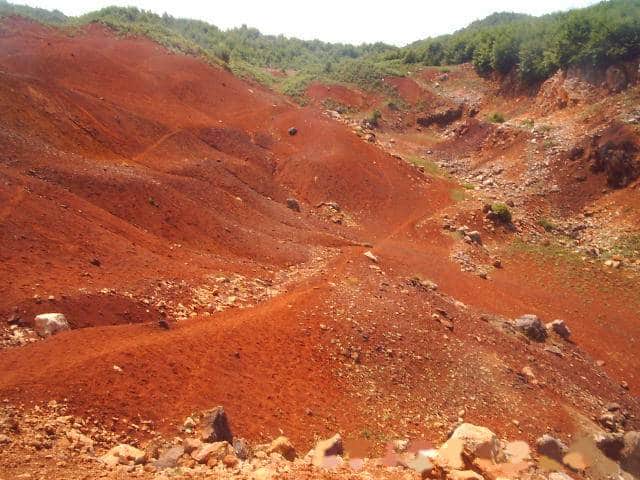
Forest Soil/ Mountain Soil
Formation – It is principally found on mountains with steeper slopes, high relief, shallow profiles.
Characteristics
- It is thin layered and the profiles and horizons are poorly developed
- Due to fast drainage, it has been vulnerable to soil erosion
- It is rich in organic content – humus content is also adequate but other nutrients aredeficient
- It is a loamy soil when sand, silt, and clay are in mixed form
Distribution
- These are generally found over 900m altitude
- Himalayas, Himalayan foothills, mountain slopes of Western Ghats, Nilgiri, Annamalai, and Cardamom hills
- Significance – It is very helpful to those crops which need favourable air and water drainage which is provided by this soil by virtue of being on slopes
- Generally used for rubber plantation, bamboo plantation and also tea, coffee, and fruits farming
- Large area also given to shifting agriculture where the soil fertility deteriorates after 2-3 years
- Due to less scope of agriculture, silvi pastoral farming (forest+grasses) can be sustained.
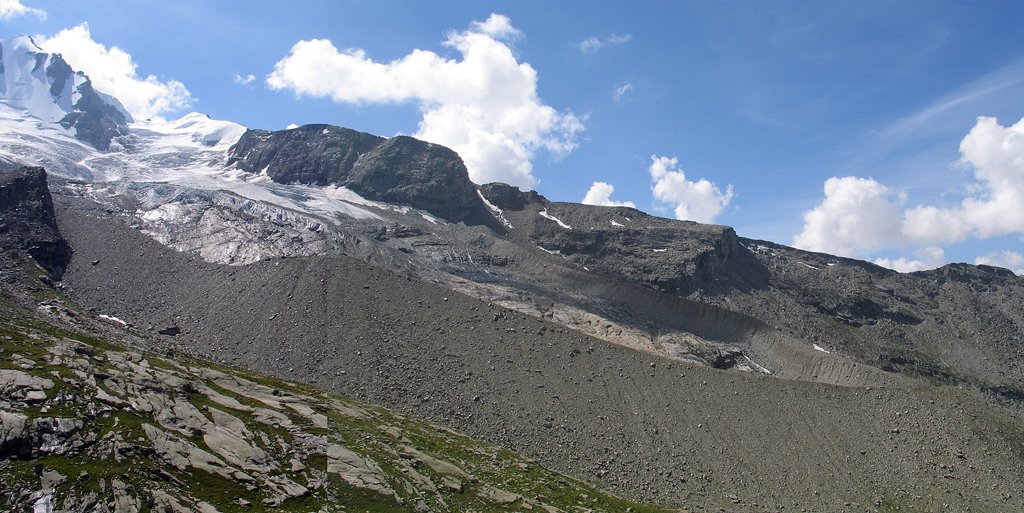
Desert Soil
- This soil is deposited by wind action and mainly found in the arid and semi-arid areas like Rajasthan, West of the Aravallis, Northern Gujarat, Saurashtra, Kachchh, Western parts of Haryana, and southern part of Punjab.
- It lacks in moisture content. Humus content is less, and Nitrogen is originally low but some of it is available in the form of nitrates.
- They are sandy with low organic matter. Living microorganisms are low in content
- It is rich in iron contents. Phosphorous content is nearly adequate, rich in lime and bases.
- It has low soluble salts and moisture with very low retaining capacity.
- If irrigated this soil gives a high agricultural return.
- These are suitable for less water-intensive crops like Bajra, pulses, fodder, and guar.
Distribution –western Rajasthan, Rann of Kachchh, in patches in south Haryana and south Punjab.

Saline and Alkaline Soil
- Alkali soil contains a large content of NaCl
- The soil is infertile
- These are also called Reh, Usar, Kallar, Rakar, Thur, and Chopan.
- These are mainly found in Rajasthan, Haryana, Punjab, Uttar Pradesh, Bihar, and Maharashtra.
- Sodium chloride and sodium sulphate are present in this soil. It is suitable for leguminous crops.
- Formation and distribution – It is both natural and anthropogenic
- Natural – Includes dried up lakes of Rajasthan and Rann of Kuchchh
- It has emerged in the Palaya basin ( a clay basin in the midst of the desert)
- Anthropogenic –It is developed in western UP and Punjab due to faulty agriculture.
- Natural – Includes dried up lakes of Rajasthan and Rann of Kuchchh
- Characteristics – Lack of moisture, humus, and living microorganisms, as a result, humus formation is almost absent
Peaty, and Marshy Soil/Bog Soil
This soil originates from the areas where adequate drainage is not possible. It is rich in organic matter and has high salinity. They are deficient in potash and phosphate.
- Characteristics – Dominance of clay and mud which make it heavy
- Rich in moisture content but at the same time, greater content of salt and every day inundation by high tide has made it infertile soil
- No organic activity due to excessive moisture content
- Distribution – It is characteristic of the delta region of India
- Besides the delta region, it is also found in
- Alleppey(Kerala) (known as Karri along the backwaters or Kayals of Kerala)
- Almora (Uttaranchal)
- Besides the delta region, it is also found in
- Significance – Over Bengal delta, it is suitable for jute and rice, and over Malabar, it is suitable for spices, rubber, big sized rice
- It has to some extent been favorable to the Mangrove forests of India.
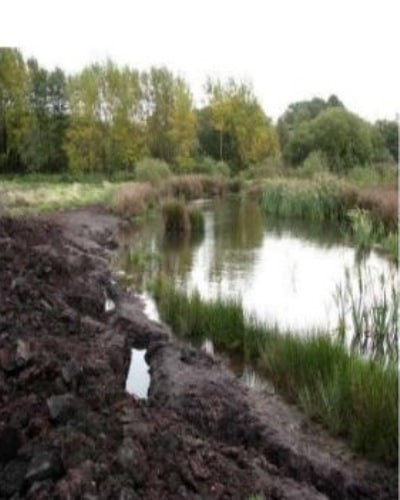

Characteristics of Indian Soils
- Most soils are old and mature. Soils of the peninsular plateau are much older than the soils of the great northern plain.
- Indian soils are largely deficient in nitrogen, mineral salts, humus and other organic materials.
- Plains and valleys have thick layers of soils while hilly and plateau areas depict thin soil cover.
- Some soils like alluvial and black soils are fertile while some other soils such as laterite, desert and alkaline soils lack in fertility and do not yield good harvest.
- Indian soils have been used for cultivation for hundreds of years and have lost much of their fertility.
Problems of Indian Soils
- Soil erosion (Himalayan region, Chambal Ravines, etc.), deficiency in fertility (Red, lateritic, and other soils), desertification (around Thar desert, rain-shadow regions like parts of Karnataka, Telangana, etc.), waterlogging (Punjab-Haryana plain) salinity, and alkalinity (excessively irrigated regions of Punjab, Haryana, Karnataka, etc.), wasteland, overexploitation of soils due to increase in population and rise in living standards and encroachment of agricultural land due to urban and transport development.

Sir how to download pdf…..
Kindly help sir…
You can copy-paste in your OneNote/Word.
I want history notes also please upload history .
Working on it
You people are doing great works. Please keep uploading. God bless you
Thanks, Rickta for your kind words.
so enriched content on soil classification
Such an elaborated and enhanced description is something we commonly find missing even in the notes of reputed coaching. Great work sir!
Thanks
thank you
Very nice.. Nd one thing i must tell u.. I know u.. We had talked in telegram once.. When u send me the link of lotus. ..keep it up.. I wish i could make it in pdf nd print it
Thank you Lotus Arise…
You gave all important information at one place,Cover each and every topic with its 360°dimension…I covered almost all geography topics from your source only….I assured you that in recent future Lotus Arise will be king of Civil service in India
Very informative
very good
Thanks
very good content.thank u
ohh beautiful article.. you dnt have to go anywhere …. everything beautifully mention ….great …. it save my time ..thanks
Doing great work, thanks
who was done first detailed and scientific soil classification of maharashtra in 1938..
option ! A) dr kellogg and dr thorp
B)dr Basu and dr sirur
Thank you so much for the comprehensive content
I am from kashmir ..this is one of the most helpful site ever
Kudos to the team
This was pretty wholesome! 👌🏻
i bow down to your selfless service, let your generations be happy
Please add more about the importance of the soils as UPSC had asked many questions on importance in past ..it would be of great help thank you…keep up the great work that you are doing
No they haven’t
3 qns in last 12 yrs … And those regarding location and characteristics mainly
sir do u have any idea of releasing book in geography ?
If more people will request, then I will think about this.
Please do sir.
I never saw such a compounded material ever sir . Please do upload all subjects. Thank you so much sir ☺️☺️☺️
esa content kisi bhi jo ias k naam se channel chala rhe he kahi nhi milega….mne world geography and indian geography isi se cover kr rha hu or pichle 1 saal se follow kr rha hu.
sar jhuka ke pranam aapko…..
Thanks for your kinds words, Keep Reading.
Can not explain enough how helpful these notes are! Fine work. Thank you so much.
Dear Sir
I Can’t explain it in words, How dearly you are helping us..
Your content is really indispensable and easy to learn and revisable..
Keep Going Sir..📚
And Thanks for you unconditional support ♥️
such a complete and in an elaborated form.. very helpful !!
Guru dev apke me apke charan sparsh me🙏